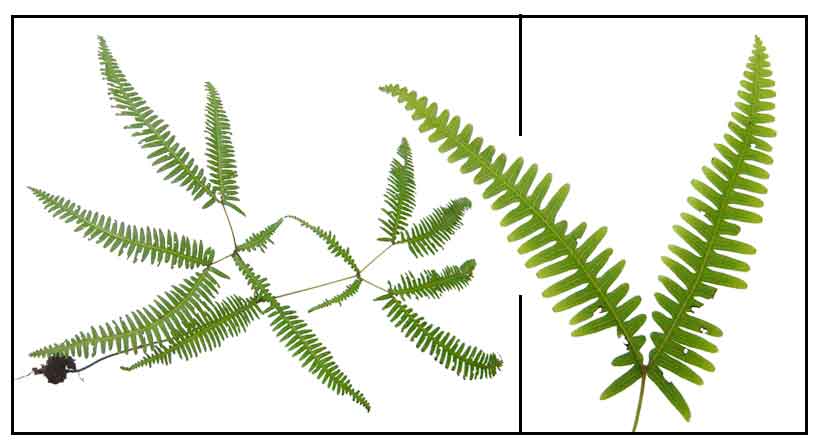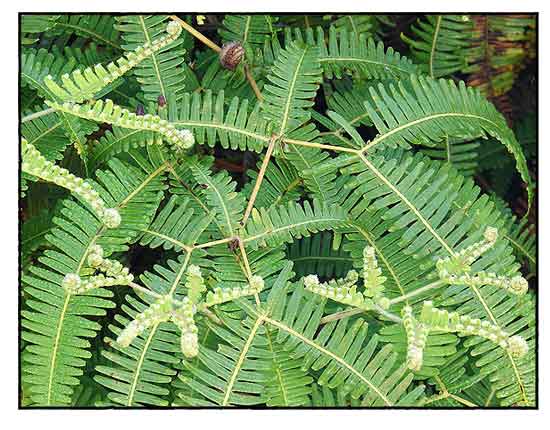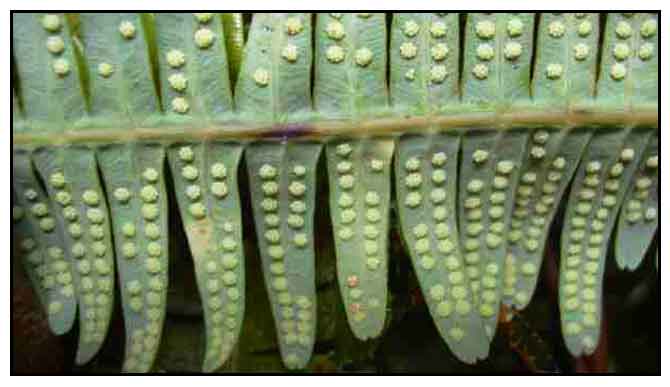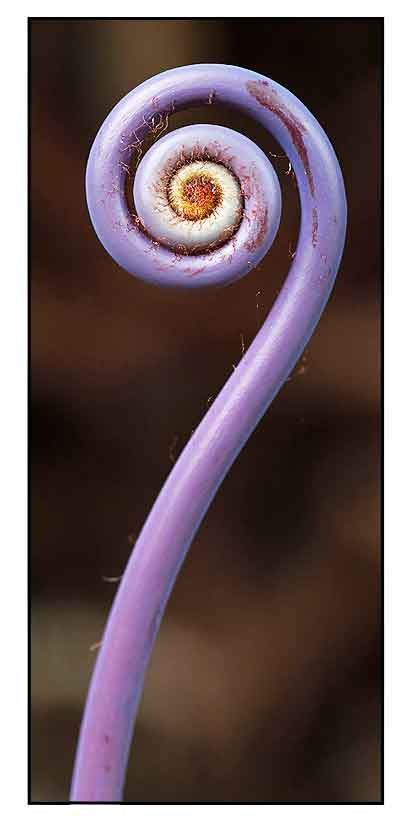|  Gen info Gen info
- The forked ferns are the family Gleicheniaceae, which includes 6 genera and about 160 known species.
-
Dicranopteris (forked fern) is a genus of tropical ferns in the family Gleicheniaceae comprising about 20 species.
- Etymology: The genus name Dicranopteris means two-branched. The species epithet linearis means narrow and parallel-sided, referring to the fronds.
-
A plant story is told that Diliman district in Quezon City, home of the University of the Philippines Diliman campus derives its name from Dicranopteris linearis, locally known as 'Dilim" with the suffix 'an' to indicate where the fern is common. (21)
 Botany Botany
Kilob is a vigorously creeping ground fern with
long branching stems and slender rhizomes, growing up to several meters long,
with very large fronds that repeatedly forks, with budlike structures in the forks. Segments are linear or broader. Sori are few and brown on
the underside, with no indusium.
Distribution
- Native to the Philippines.
-
Widely distributed in the Philippines,
frequently forming dense tangles in open places in mountains.
- Found throughout the tropics and in Japan and New Zealand; abundant in the Malay Peninsula.
- Also native to Andaman Is., Assam, Australia, Bangladesh, Borneo, Cambodia, China, Fiji, Himalaya, Hawaii, India, Jawa, Samoa, Sri Lanka, Sulawesi, Sumatera, Thailand, Vietnam etc. (13)
Constituents
- Study showed the leaves to be a good source of micronutrients.
- Study yielded flavonoids +, triterpenes +, tannins +, saponins +++, steroids +++.
- Phytochemical screening yielded phenols, flavonoids, total
sugar, protein, vitamin C, carotenoids, tannin, chlorophyll, reducing sugar, and α-tocopherol. Predominant phenolics were catechin, caffeic, ferulic, salicylic and vanillic acid. (see study below). (17)
- Study of acetone and chloroform extracts of aerial parts yielded 13 bioactive compounds. Prevailing compounds in acetone extract were 3-Ethoxyacrylonitrile (61.93%), Indole-2-one, 2, 3-dihydro-N-hydroxy-4-methoxy-3, 3-dimethyl- (10.78%), Silicic acid, diethyl bis (trimethylsilyl) ester (14.43%) and 2-Ethylacridine (12.85%). The prevailing compounds in chloroform extract were 1H-Inden-1-ol, 2,3-dihydro- (2.88%), Phenol, 2,5-bis(1,1-dimethylethyl)- (6.48%), Heptacosane (2.20%), Di-n-decylsulfone (6.43%), Ethanone, 2-(2-benzothiazolylthio)-1-(3,5-dimethylpyrazolyl)- (15.24%), 1-Bromoeicosane (15.11%), Methoxyacetic acid, 2-tridecyl ester (19.05%), Octadecane, 3-ethyl-5-(2-ethylbutyl)- (20.59%) and 1,2,4-Benzene tricarboxylic acid, 4-dodecyl dimethyl ester (12.02%).
(30)

Properties
- Considered antiasthmatic, febrifuge, anthelmintic.
- Studies have suggested antibacterial, antinociceptive, anti-inflammatory, antioxidant and hepatoprotective, cytotoxicity, antidepressant, antibiofilm properties.
Parts utilized
Leaves, roots.
 Uses Uses
Edibility
- Study showed the leaves to be a good source of micronutrients.
Folkloric
- Young leaves are used as poultice,
decoction or infusion for fever.
- Poultice of leaves used for wound dressing.
- Plant used as antiasthmatic.
- In Indo-China, used as
anthelmintic.
- Roots of pulasan (Nephelium mutabile) are boiled with G. linearis and used for bathing feverish patients.
- Used for bloody diarrhea.
- Fern used to treat boils, ulcers, and external wounds.
-In east New Britain, bound externally to wounds, cuts and sores.
- In India, young leaves mixed with cow milk used for seven days to remove sterility in women.
- In Malaysia, crushed leaves used as poultice to control fever; juice of leaves used in baths for fever. In Indo-China, plants used to rid of intestinal worms.
- In New Guinea, used to treat boils, ulcers and wounds.
- In Thailand, decoction drunk against insomnia; also used for bathing children with skin rash. In Hawaii, plant extract drunk to cure constipation. (23)
Others
- Crafts: In India, petioles and racheae used thatching huts. Also used for making writing pens. In DR congo, leaf axes used for making basket-type fish traps and plaited for making local beds. In Gabon, hollow stems used for drinking palm wine and as children's blowpipe toy. In Asia, fibers used for plaiting, basketry, ropes, caps, arm bands and belts. (23)
Studies
• Antioxidative / Antibacterial: In a study of leaf extracts of five medicinal ferns, G linearis showed to have antioxidative potential and antibacterial activity justifying its use in traditional medicine. (1)
• Antinociceptive / Anti-Inflammatory / Antipyretic: Study of the chloroform extract of Dicranopteris linearis showed it to possess antinociceptive and anti inflammatory activity and justifies its traditional use by the Malays, especially for fever. (4)
• Antibacterial: Petroleum, acetone, methanol and water extracts of Dicranopteris linearis exhibited antibacterial activity, maximum with the acetone extract. (5)
• Antioxidant / Cytotoxic / Leaves: Study showed leaves of D. linearis possess potential cytotoxic activity against various types of cancer cell lines depending on the types of extracts and their phenolic content. (9)
• Antioxidant: Study of aqueous extract of leaves showed antioxidant property, partly through free radical scavenging activity. (10)
• Metal Sorbent for Lead Ions Removal: Lead is a heavy metal in industrial wastewater. The use of plant biomass such as fern tree Gleichenia linearis as metal sorbent offers an a potential treatment and removal alternative. Study showed high lead ion removal at 5 mg/L concentration, pH 5 and with smaller sorbent size, <500 um. (12)
• Hepatoprotective / Paracetamol and Carbon Tetrachloride Toxicity / Leaves: Study evaluated the hepatoprotective activity of Dicranopteris linearis leaf aqueous extract in two models of liver injury in rats induced by paracetamol and carbon tetrachloride. Results showed DLAE possess hepatoprotective activity which could be attributed to its free radical scavenging and antioxidant activities, and high flavonoid contents. (14)
• Chemopreventive / Leaves / DMBA-Croton Oil-induced Mouse Carcinogenesis: Study evaluated a methanol extract of Dicranopteris linearis for chemoproventive potential in a two-stage mouse skin carcinogenesis model. Results showed anti-carcinogenic effect in a dose-dependent manner. (15)
• Antimicrobial: Study evaluated the antimicrobial activities of extracts of dried leaf powder. Results showed high antibacterial activity against S. aureus and S. typhi and antifungal activity against Curvularia lunata, Macrophomina phaseolina and Aspergilus niger. (16)
• Phytochemical Screening of Bioactive Compounds: Study screened and quantified the phytochemicals present in D. linearis and Pteris vittata. Quantitatively, the phenol, flavonoid, total sugar, protein, vitamin C and carotenoid were higher in Dicranopteris linearis than P. vittata, while tannin, total chlorophyll, chlorophyll a & b, reducing sugar and α-tocopherol were higher in P. vittata. Predominant phenolics were catechin, caffeic acid, feruli, salicylic and vanillic acid. (17)
• Gastroprotective / Ethanol-Induced Mucosal Injury: Study evaluated the gastroprotective effect of ethanolic leaf extract of D. linearis against ethanol-induced gastric mucosal injury in experimental rats. Results showed significant protection of gastric mucosa with increase gastric mucus production and decreased gastric acidity and gross reduction of ulcer area. (18)
• Cytotoxicity / Leukemia Cell Line / Leaves: Study evaluated various extracts of dried leaves of D. linearis against Hl-60 (acute promyelocytic leukemia cell lines) and WRL 68 (normal liver cell line). The methanol extract showed promising cytotoxic activity against HL-60 (IC50=7.9 µg/ml. Fractionation of the methanol extract showed F7 with the best cytotoxic activity with an IC50 value of 25.12µg/ml. It was found to be non-toxic against normal cells. (19)
• Hepatoprotective / Acetaminophen Toxicity / Leaves: Study evaluated the potential of methanolic extract of D. linearis leaves to attenuate liver intoxication induced by acetaminophen (APAP) in rats. Pretreatment with ME at all doses significantly (p<0.05) reduced ALT and AST while levels of CAT and SOD were significantly (p<0.05) restored to normal level. Histopathological exam showed remarkable improvement in liver cells architecture with increased dose of extract. HPLC and GCMS studies revealed presence of non-volatile (rutin, gallic acid, etc) and volatile (methyl palmitate, shikiic acid, etc) bioactive compounds. The hepatoprotective activity was attributed via ability to partly activate the endogenous antioxidant system and presence of bioactive compounds that might act synergistically. (22)
• Antibacterial / Antibiofilm / Antibiotic-Potentiating / Polyphenol-Rich Fraction: Study evaluated the potential of a standardized polyphenol-rich fraction of D. linearis in counteracting planktonic and biofilm bacteria in skin wounds, by itself or in combination with conventional antibiotics. DL fraction exhibited dose dependent antibacterial effect of S. aureus and P. aeruginosa. The fraction synergized with penicillin G, ampicillin and chloramphenicol to significantly inhibit growth of S. aureus and MRSA. Combination with vancomycin reduced the antibiotic dose required to prevent biofilm formation. Results support the traditional use for skin bacterial infections and suggest potential as an adjunct to conventional antibiotics for management of infected wounds. (24)
• Antidepressant / Serotonergic, Noradrenergic, Opioidergic Responses / Leaves: Study evaluated the serotonergic, noradrenergic and opioidergic response of D. lineraris leaf extracts in Swiss albino mice. Forced Swim Test (FST) and Tail Suspension Test (TST) were used to evaluated antidepressant potential. In both FST and TST, the duration of immobility was reduced by imipramine and the ethanol extract In FST. The ethyl acetate extract increased climbing time in FST suggesting noradrenergic action and decreased swimming time suggested deficit of serotoninergic mechanism. Of the three extracts, the ethanol extract was more potent. Results suggest D. linearis is a potent antidepressant agent. (25)
• Lack of Antimicrobial Activities / Leaves: Study evaluated the antimicrobial activity of aqueous, chloroform, and methanol extracts of leaves of D. linearis using micro-broth dilution method against strains of S. aureus, E. coli, and C. albicans. The methanol extract was most active with MIC/MBC values of 625 µg/ml. Subsequent fractionation of ME yielded 11 fractions Only B5, B6, and B11 fractions showed activity with MIC/MBC values between 1250-2500 µg/ml. Results showed only mild antibacterial activity against the selected panel of microbes and reflects that lack of claim as antimicrobial. (26)
• Suppression of CNS Functions / GABA-Mediated / Leaves: Study evaluated the potential of three different leaf extracts (aqueous, ethanol, and ethyl acetate) of D. linearis in altering CNS functions using Morris Maze, Elevated Plus Maze, Open Field, Hole Cross, and Head Dip tests. Results showed the ethanol extract significantly suppressed CNS activity by reducing number of locomotor activities and increase stability phase ( EPM and Morris Maze tests) supporting mild sedation, depression, and anxiolysis. The EA extract showed moderate to high potential in reducing locomotor activities. Results suggest the plant mimics the activity of a GABA (gamma-aminobutyric acid) agonist and suggests a GABA-mediated involvement in the CNS. (27)
• α-tocopherol / Disruption of S. aureus Biofilm / Leaves: Study evaluated the potential of D. linearis leaves and components for disrupting ability against Staphylococcus aureus biofilms. Among various fractions tested, only the hexane fraction showed biofilm disrupting ability, with 60-90% disruption activity against all four S. aureus strains tested. Bioassay-guided purification of active fraction isolated
α-tocopherol, which did not affect cells within the biofilms but instead affects the biofilm matrix to disrupt S. aureus biofilms. Results suggest potential for α-tocopherol as a biofilm disruptive agent to treat biofilm-associated infections in the future. (28)
• REE (Rare Earth Elements) Detoxification / Leaves: Dicranopteris linearis is the best known hyperaccumulator species of rare earth elements (REEs) and silicon (Si), capable of dealing with toxic levels of REEs. Study evaluated how D. linearis leaves cope with excessive REE stress and whether Si plays a role in REE detoxicification. Results suggest Si-pectin matrix fixation is key in REE detoxicification in D. linearis, laying foundation for phytotechnological applications (e.g., REE phytomining) using this species in REE-contaminated sites. (29)
Availability
Wildcrafted. |


 Gen info
Gen info




